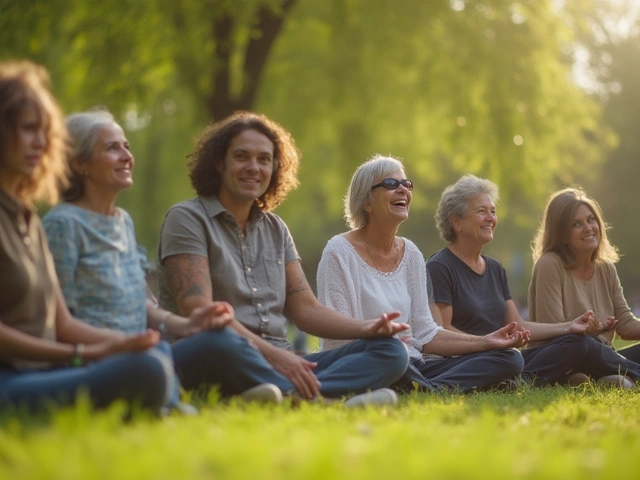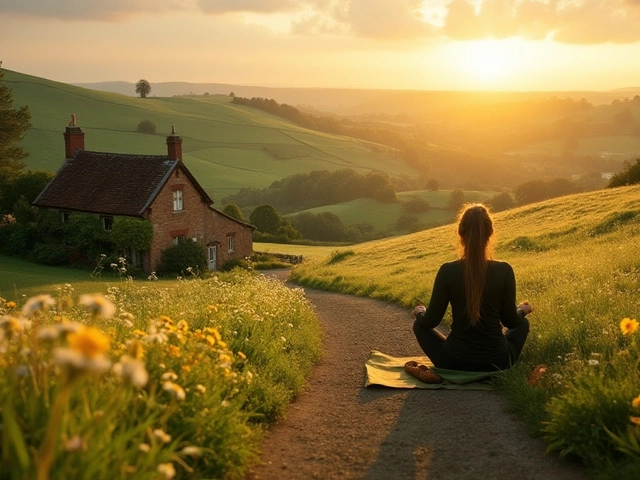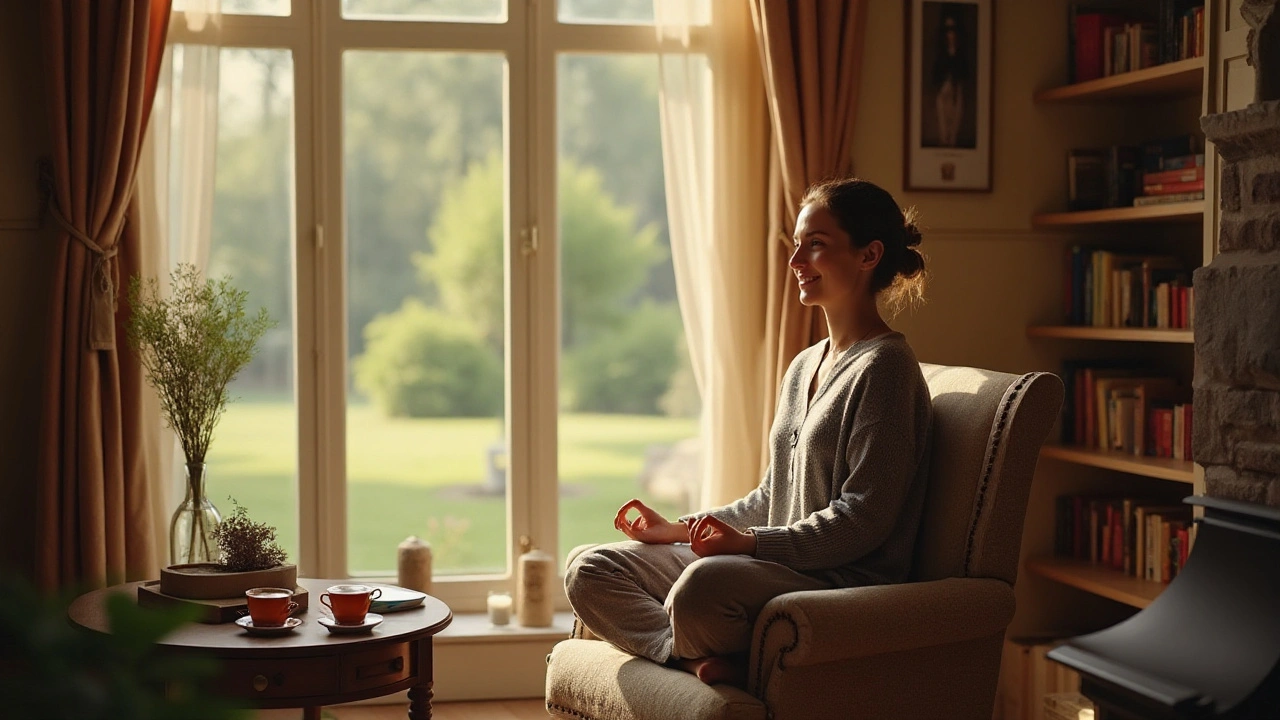
Life has a way of spinning us in multiple directions at once. Finding calmness may seem like a distant dream when your to-do list keeps growing. But it is possible, and even small changes can make a big difference.
Understanding what calmness is and why it matters is the first step. It's not just a state of relaxation, but a foundation for our mental and emotional health. Integrating mindfulness exercises into your day can help center your thoughts and bring clarity. Meditation, even for a few minutes, can offer immense benefits.
Our surroundings play a significant role in how we feel. Creating a space where you can escape the daily grind, even for a short while, can be incredibly soothing.
How you treat your body also affects your mind. Regular exercise and a balanced diet can contribute greatly to your sense of well-being. Discovering what works best for you and making it a habit will support your journey to calmer days.
Lastly, consider small daily practices that help maintain equilibrium. Reading, taking short breaks, or even managing your time efficiently. By implementing these steps, it's possible to cultivate a calmer, more balanced life.
- Understanding Calmness
- Mindfulness and Meditation
- Creating a Peaceful Environment
- The Role of Exercise and Diet
- Practical Daily Habits
Understanding Calmness
Calmness is more than just a lack of stress. It's a proactive state where the mind and body are in harmony, fostering overall well-being. This balance doesn't come naturally to most people in our fast-paced society. Often, calmness is misunderstood as complacency or inaction. In reality, it's a dynamic and active pursuit of mental and emotional stability.
Research highlights the beneficial effects of calmness on the brain. According to the American Psychological Association, individuals who frequently experience calmness have lower levels of cortisol, the stress hormone. This reduction in cortisol not only impacts mood positively but also bolsters the immune system, making us physically healthier and more resilient to illness.
It's essential to recognize that calmness can be trained and cultivated. Practices such as meditation and mindfulness are proven methods to achieve a calmer state of mind. Regularly setting aside moments to focus on the present can significantly reduce the stress experienced throughout the day. As Jon Kabat-Zinn, a pioneering teacher of mindfulness, noted:
“Mindfulness means paying attention in a particular way: on purpose, in the present moment, and non-judgmentally.”
Another key to understanding calmness is acknowledging the role of our environment. Our surroundings can either facilitate a sense of peace or contribute to chaos. A well-organized, serene space can significantly enhance our ability to stay calm. Simple changes, such as decluttering your workspace or incorporating elements like plants and natural light, can make a world of difference.
Physical well-being is another cornerstone of calmness. Regular physical activity has profound effects on mental health. Exercise releases endorphins, natural mood lifters, which can help maintain a balanced emotional state. Additionally, a nutritious diet contributes to mental clarity and stability, making it easier to handle daily stressors.
Calmness also involves recognizing and managing emotions effectively. Emotional intelligence, the ability to understand and manage your own emotions and the emotions of others, is critical. Practicing empathy and self-awareness can foster deeper interpersonal relationships and create a supportive network, which further enhances a sense of calm.
Interestingly, studies show that engaging in creative activities like painting, writing, or even gardening can foster a sense of calm. These activities don't just act as distractions but help in centering the mind and promoting a relaxed state.
In Perth, Australia, many initiatives encourage people to explore diverse methods of achieving calm. From beach yoga sessions to forest therapy walks, the options are plentiful. Exploring what personally resonates can uncover the most effective strategies for maintaining calmness.
In summary, understanding calmness involves a multi-faceted approach that includes awareness, environmental adjustments, physical wellness, emotional intelligence, and creative outlets. By incorporating these elements, one can navigate the complexities of a busy world with greater ease and tranquility.
Mindfulness and Meditation
Mindfulness and meditation have become more than just buzzwords; they are lifelines in today's fast-paced world. The practice of mindfulness involves paying full attention to the present moment without judgment. It’s about becoming more aware of what you are experiencing, both internally and externally. This awareness can help in reducing stress, improving focus, and fostering a sense of calm.
The roots of mindfulness come from ancient Buddhist traditions, but the modern, secular practice has been popularized by figures like Jon Kabat-Zinn. His work at the University of Massachusetts Medical School showed that mindfulness can have significant positive impacts on both mental and physical health. According to a study published in the Journal of the American Medical Association, individuals who engaged in an eight-week mindfulness-based stress reduction program reported reduced symptoms of anxiety and depression.
Meditation, a tool often used to cultivate mindfulness, helps quiet the mind. Starting with just a few minutes a day can be beneficial. One simple technique is to focus on your breath. Sit comfortably and pay attention to the sensation of breathing in and out. When your mind wanders, as it inevitably will, gently bring it back to your breath. This practice can help you develop a greater sense of calm, clarity, and control over your thoughts.
There are various types of meditation, including guided meditation, where a narrator leads you through the process; transcendental meditation, which involves silently repeating a mantra; and loving-kindness meditation, which focuses on developing feelings of compassion. Each type offers different benefits, and exploring them can help you find what works best for you.
Technology has also played a role in making meditation more accessible. Apps like Headspace and Calm offer guided sessions that can fit into even the busiest schedules. These platforms provide a variety of meditations tailored to different needs, whether it's stress relief, improved sleep, or enhanced focus.
According to a report from the Harvard Business Review, integrating mindfulness programs in the workplace has resulted in employees experiencing reduced burnout and increased productivity. Companies like Google and Intel have incorporated mindfulness training into their employee wellness programs with remarkable success.
Incorporating mindfulness and meditation into daily life doesn't require major changes. It can be as simple as taking a few moments each day to sit quietly and reflect, or practicing mindful eating by savoring each bite of your meal. By making these practices a part of your routine, you can cultivate a sense of calm and presence that will help you navigate the demands of a hectic world.
"Mindfulness isn't difficult. We just need to remember to do it." – Sharon Salzberg
Long-term benefits of these practices go beyond stress relief. Regular meditation can improve overall mental health, according to the National Institute of Health. It can also promote better emotional health, enhance self-awareness, and even lengthen attention spans. In a world that rarely stops moving, finding calm within oneself is not just a luxury—it’s a necessity.
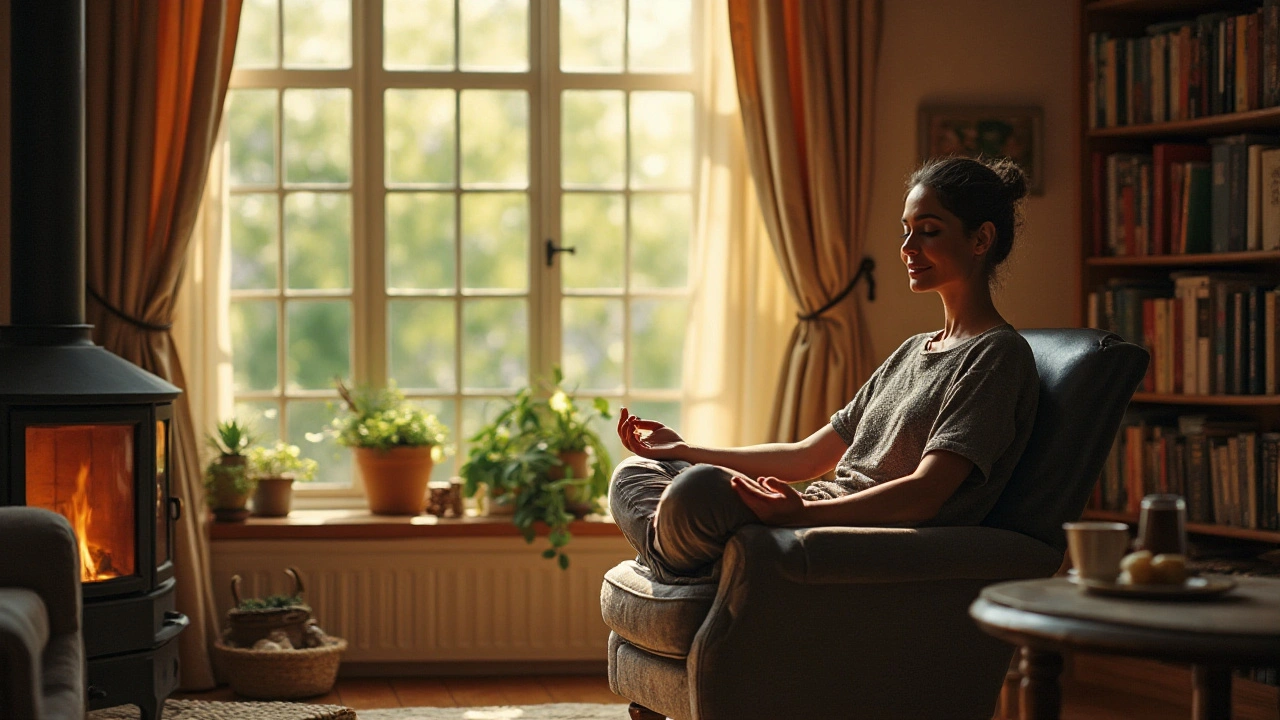
Creating a Peaceful Environment
Our surroundings significantly influence our state of mind. Imagine walking into a room filled with clutter and noise—it can immediately heighten stress levels. On the other hand, a tidy and calming space can promote relaxation and mental wellness. The importance of a peaceful environment cannot be overstated when it comes to achieving calmness in a busy world.
Start by decluttering your living or working space. A clean area helps clear the mind and reduces distractions. Try to keep surfaces tidy and organized. Dispose of items you no longer need, and find efficient storage solutions for things you wish to keep. This act alone can be incredibly rewarding and is a step toward a more serene environment.
Another key element is incorporating elements of nature. Houseplants are an excellent way to bring a touch of greenery into your space. They can improve air quality and create a soothing atmosphere. Choose plants that are easy to care for, like succulents or ferns, and place them in areas where you spend the most time. Soft, natural lighting also plays a crucial role in creating a calm environment. Use sheer curtains to allow natural light in or invest in warm, ambient lighting options to add a cozy feel.
Decor plays an essential role too. Opt for colors that promote calm and relaxation, such as soft blues, greens, and neutrals. These colors have a naturally calming effect. You might also consider creating a dedicated relaxation area where you can unwind and recharge. This could be a cozy corner in your living room with a comfortable chair and some blankets or a quiet nook where you can read or meditate undisturbed.
"Your home should be the antidote to the stress of the world, not the cause of it." – Peter Walsh
Sensory elements can foster a tranquil atmosphere. Aromatherapy, for example, is known for its relaxing properties. Scents like lavender, chamomile, and sandalwood can help elevate your mood and decrease anxiety. Diffusers or candles can be used to spread these soothing scents throughout your space. Soft music or nature sounds can further enhance the peaceful ambiance, providing a retreat for your senses.
Additionally, consider the layout of your space. Ensure there is a natural flow, with plenty of room to move around freely. This means not overcrowding the room with furniture and making sure that walkways are clear. A spacious feel can actually contribute to feeling less confined and more at ease. Also, personal touches, like family photos or artwork that you love, can provide a sense of comfort and serenity.
If you work from home, it's vital to create a clear distinction between your working area and relaxation zones. Your workspace should be organized and free from unnecessary stressors. Ergonomic furniture is also a wise investment to ensure comfort while working. At the end of your workday, physically move away from your workspace to signal to your mind that it’s time to relax.
Finally, keep in mind that it's a journey, not a destination. Your space evolves with you, and maintaining a peaceful environment is an ongoing process. Regular maintenance, occasional decluttering, and updates to reflect changes in your life and preferences all contribute to sustaining a calm and welcoming atmosphere. By creating a peaceful environment, you are setting the stage for a calmer state of mind and a more balanced life.
The Role of Exercise and Diet
Exercise and diet aren't just about looking good or following trends. They play pivotal roles in how we manage stress and maintain our mental wellness. Regular physical activity increases the production of endorphins, which are chemicals in the brain that act as natural painkillers and mood elevators. These 'feel-good' hormones help reduce stress and anxiety.
For starters, setting aside time each day for exercise can be immensely beneficial. It doesn't have to be an intense workout session. Even a simple walk in the park can do wonders for your mood. Studies show that people who engage in regular physical activity have better control over their stress levels and exhibit lower instances of depression and anxiety. It acts as a consistent tool to fend off the pressures and strains of daily life.
Now, when it comes to diet, the saying 'you are what you eat' holds a lot of truth. A balanced diet rich in fruits, vegetables, lean proteins, and whole grains can significantly impact your mental state. Avoiding excessive amounts of sugar and caffeine is also crucial. These might give a temporary boost, but they often lead to energy crashes and mood swings. Including foods high in omega-3 fatty acids, like salmon and chia seeds, can aid in reducing anxiety and promoting mental calmness.
"The food you eat can either be the safest and most powerful form of medicine or the slowest form of poison." – Ann Wigmore
It's also important to stay hydrated. Dehydration can affect your mood, energy levels, and overall mental clarity. Make drinking water a regular habit rather than just an afterthought. Try carrying a reusable water bottle with you as a reminder.
Combining the right exercise routine with a nutritious diet creates a holistic approach to achieving calmness in our busy world. Not only does this combination boost physical health, but it also enhances mental resilience. So, whether it's taking up yoga, jogging, or simply incorporating more greens into your meals, small changes can lead to significant improvements.
By understanding the vital connection between physical activity, nutrition, and mental wellness, you pave the way for a life that is balanced and calm. It's not about making drastic changes overnight. Instead, focus on gradual adjustments that seamlessly fit into your routine.
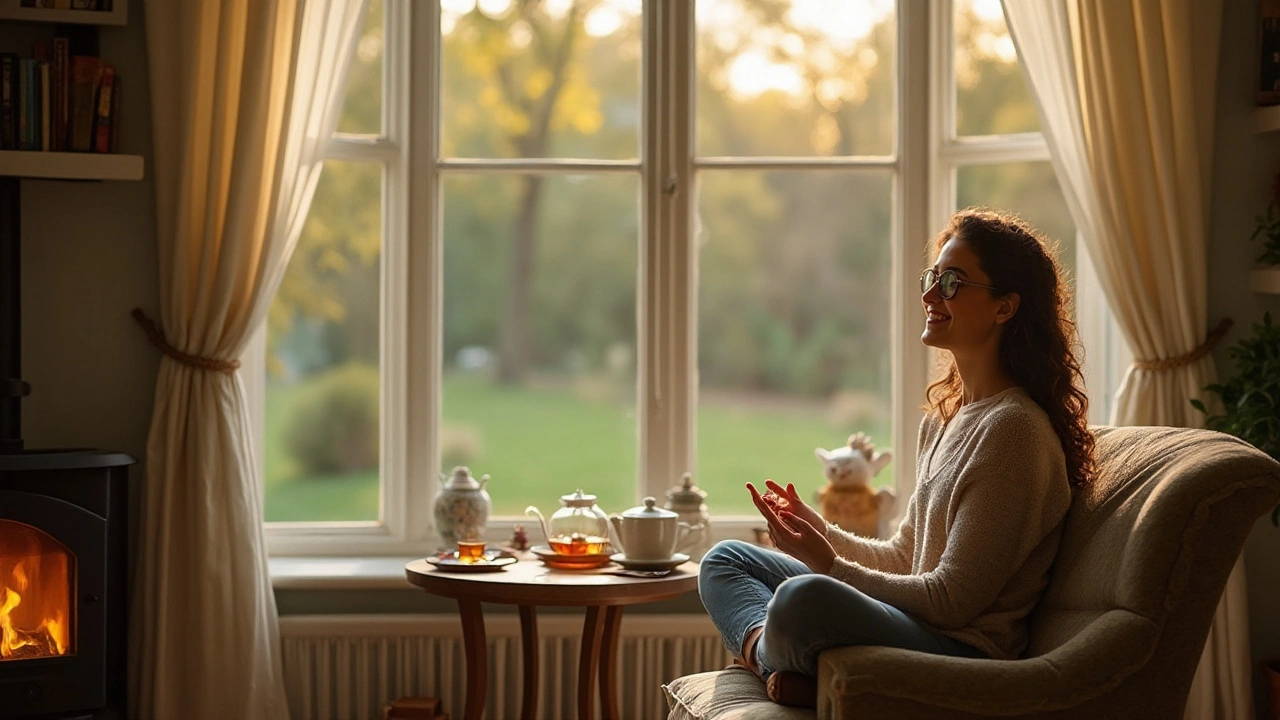
Practical Daily Habits
Building a daily routine that promotes calmness can transform your life. The key lies in consistently practicing habits that foster inner peace. Drinking a glass of water first thing in the morning, for instance, can jumpstart your body's metabolism and provide a refreshing start to your day. This seemingly small habit sets a positive tone for the day ahead.
Incorporate moments of mindfulness into your daily schedule. Take a few minutes to sit quietly and focus on your breathing. Close your eyes and let the thoughts flow. This act of centering yourself can alleviate stress and improve mental wellness. Studies have shown that regular mindfulness practices can reduce anxiety by up to 58%.
“Mindfulness is the practice of bringing one's attention to the present moment,” says Dr. John Kabat-Zinn, a prominent figure in the field of mindfulness-based stress reduction.
Creating a list of tasks you want to achieve also helps. It keeps you organized and provides a sense of accomplishment as you tick off each item. But be realistic; don't overload your list. Aim for a balance of work, rest, and play. Short breaks between tasks can re-energize you, improve focus, and reduce burnout.
Ensure you carve out time for hobbies and activities you enjoy. Whether it’s reading a book, gardening, or painting, engaging in these activities can significantly boost your mood. Physical exercise, even a 30-minute walk, can enhance your feeling of well-being and reduce anxiety.
Diet also plays a crucial role in maintaining mental health. Avoid skipping meals and include a variety of fruits, vegetables, lean proteins, and whole grains in your diet. These foods support brain function and maintain energy levels throughout the day.
Engage in social activities. Spending time with loved ones can reduce stress and remind us of what truly matters. However, recognize when you need downtime to recharge. Striking this balance is vital for nurturing healthy relationships and your own mental wellness.
Lastly, consider limiting your exposure to negative news and social media. While staying informed is essential, constant exposure to alarming news can heighten stress levels. Allocate specific times for checking updates and dedicate the rest for more uplifting activities.

